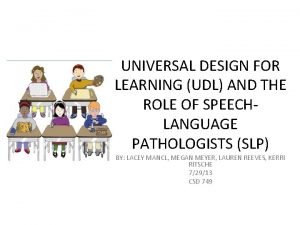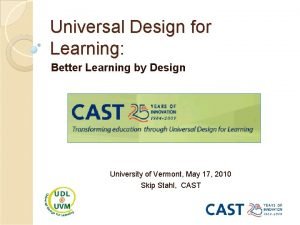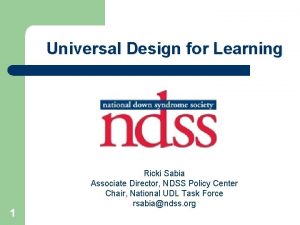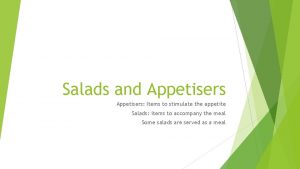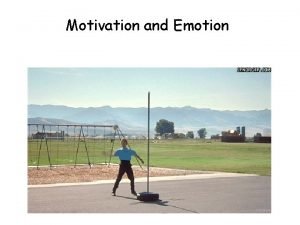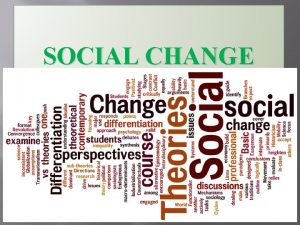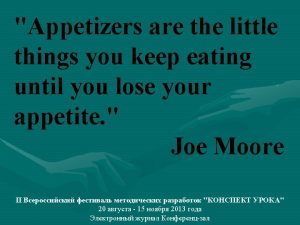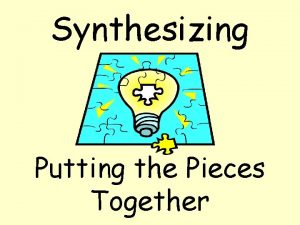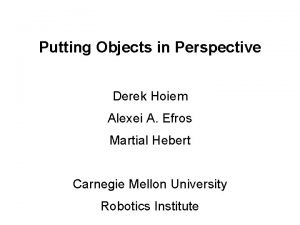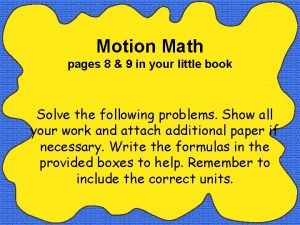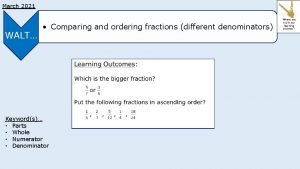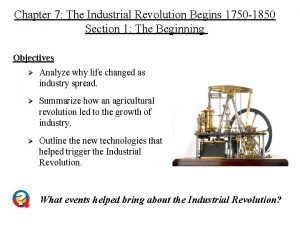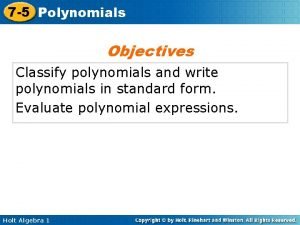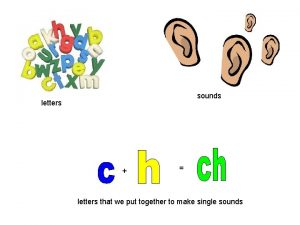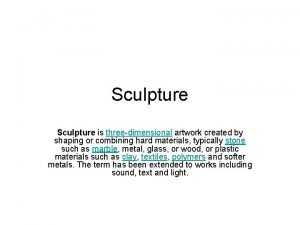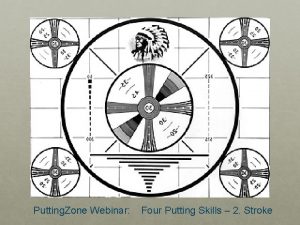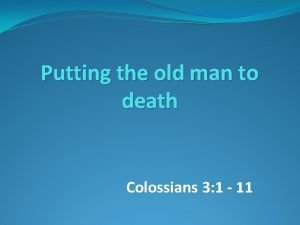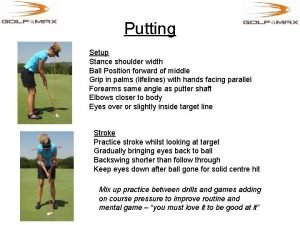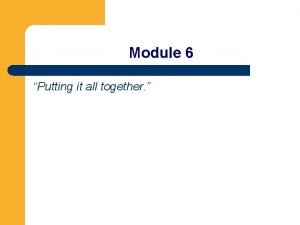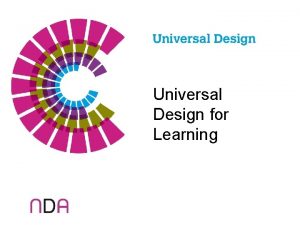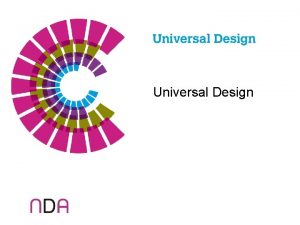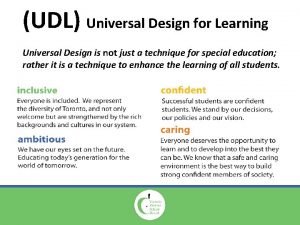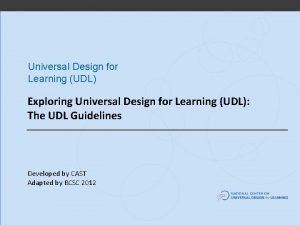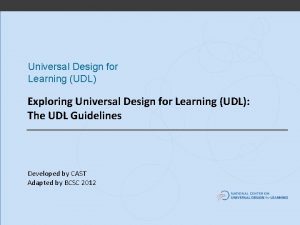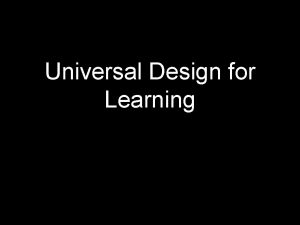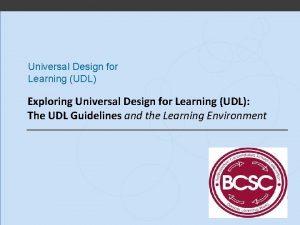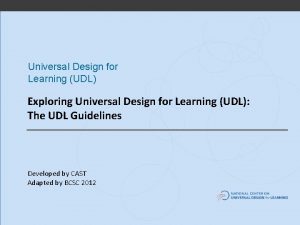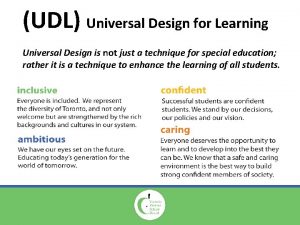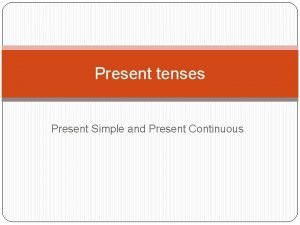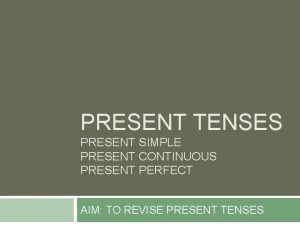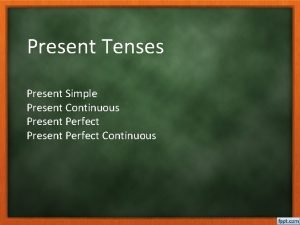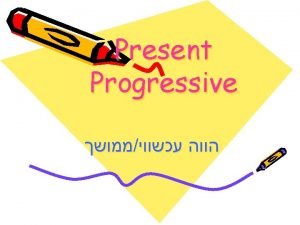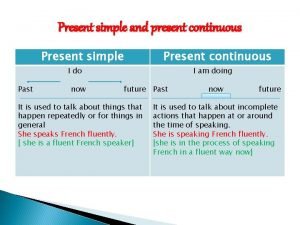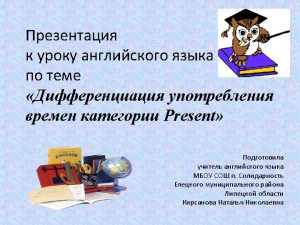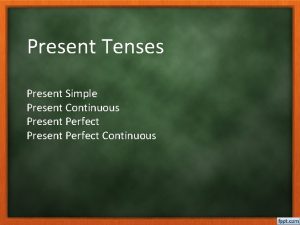Present Differentiate Stimulate Putting Universal Design for Learning




































- Slides: 36

Present, Differentiate, Stimulate: Putting Universal Design for Learning in Our Face-to. Face, Hybrid, and Online Future Jennifer Myers, Ph. D. myersjb@octech. e du 803 -268 -2560

Today’s Presentation WHY? UDL EXAMPLES CHALLENGES & LESSONS

Poll: Had you heard of UDL before today? YES NO *use the poll tool to answer

Why UDL? • Increase accessibility and reach a larger number of learners • Make content more interactive and engaging

What is Universal Design for Learning (UDL)? “a set of principles for curriculum development that give all individuals equal opportunities to learn. “

What is Universal Design for Learning (UDL)? Principle 1: Provide Multiple Means of Representation

What is Universal Design for Learning (UDL)? Principle 1: Provide Multiple Means of Representation Principle 2: Provide Multiple Means of Action and Expression

What is Universal Design for Learning (UDL)? Principle 1: Provide Multiple Means of Representation Principle 2: Provide Multiple Means of Action and Expression Principle 3: Provide Multiple Means of Engagement

What does this really mean? ? ?

Principle 1: Provide Multiple Means of Representation Present the content in different ways • Provide transcripts or Closed Captioning options for videos • Use concept maps or other graphic organizers • Provide a glossary of key terms or embed support for vocabulary within the materials

Principle 1: Provide Multiple Means of Representation (continued) Present the content in different ways • Activate prior knowledge • Highlight patterns, key ideas, and relationships • Use mnemonic devices • Use multiple types of media


Online flash cards – instructor or student created


How can you use Principle 1 in the classroom? Please type your response into the chat.

Poll: Do you now have a basic understanding of Principle 1? YES NO *use the poll tool to answer

Principle 2: Provide Multiple Means of Action and Expression Provide different ways students can express what they know • Using clickers/polls • Provide checklists to guide students • Provide 3 D models of blueprints or drawings • Concept maps (student created) • Provide rubrics



How can you use Principle 2 in the classroom? Please type your response into the chat.

Poll: Do you now have a basic understanding of Principle 2? YES NO *use the poll tool to answer

Principle 3: Provide Multiple Means of Engagement Stimulate interest (and hold it) and motivation for learning • Scaffold complex skills in order to build confidence and hold student motivation

Activity/Problem 1 Activity/Problem 2 Large amount of instructor guidance Activity/Problem 3 Activity/Problem 4 Activity/Problem 5 Activity/Problem 6 Little/No instructor guidance

Principle 3: Provide Multiple Means of Engagement Stimulate interest (and hold it) and motivation for learning • Provide options for self-reflection and self-regulation • Provide relevant and authentic activities • Provide rubrics so that students know what is expected and how learning




How can you use Principle 3 in the classroom? Please type your response into the chat.

Poll: Do you now have a basic understanding of Principle 3? YES NO *use the poll tool to answer

UDL Checklist

CHM 110: UDL Examples Module 1: Dimensional Analysis • Open Text • Video Demonstrations – You. Tube and Instructor Created with transcripts • Practice – Khan Academy and Instructor Created

CHM 110: From F 2 F to Online – Applying UDL How taught in F 2 F • Students will be able to balance chemical equations Objective New ways to present information online

CHM 110: From F 2 F to Online – Applying UDL How taught in F 2 F • Students will be able to balance chemical equations Objective • Textbook reading • Lecture Demonstration • Practice New ways to present information online

CHM 110: From F 2 F to Online – Applying UDL How taught in F 2 F • Students will be able to balance chemical equations Objective • Textbook reading • Lecture Demonstration • Practice • Open text reading • Khan Academy video • Example problems • Practice worksheet New ways to present information online

Challenges & Lessons Learned • Language can be overwhelming • Just need to tweak what already doing • Small changes have a big impact

Questions or Comments? Jennifer Myers myersjb@octech. edu 803 -268 -2560
 Decorative design patterns
Decorative design patterns 504 plan oklahoma
504 plan oklahoma Universal design for learning definition
Universal design for learning definition Universal design for learning
Universal design for learning Universal design for learning
Universal design for learning Universal design for learning
Universal design for learning Salad that stimulate the appetite of your guest
Salad that stimulate the appetite of your guest Instinct definition psychology
Instinct definition psychology What are six factors that stimulate social change?
What are six factors that stimulate social change? Appetizer are foods which stimulate the
Appetizer are foods which stimulate the Great ch
Great ch Ecological conversion meaning
Ecological conversion meaning Cuadro comparativo de e-learning
Cuadro comparativo de e-learning Putting-out system
Putting-out system What is nasreen putting chocolate on
What is nasreen putting chocolate on When was the loom invented
When was the loom invented Putting-out system
Putting-out system Summarizing vs synthesizing
Summarizing vs synthesizing Pricing tripod in service marketing
Pricing tripod in service marketing Putting objects in perspective
Putting objects in perspective Oncology nursing society putting evidence into practice
Oncology nursing society putting evidence into practice The order of putting on ppe
The order of putting on ppe Putting it all together motion answer key
Putting it all together motion answer key Ordering fractions
Ordering fractions Putting people first 2007
Putting people first 2007 Putting-out system
Putting-out system How to classify polynomials
How to classify polynomials Putting the enterprise into the enterprise system
Putting the enterprise into the enterprise system Put sounds together
Put sounds together A 3-d work of art created by shaping or combining materials
A 3-d work of art created by shaping or combining materials Putting zone
Putting zone Put to death the old man
Put to death the old man Putting the enterprise into the enterprise system
Putting the enterprise into the enterprise system Putting stance width
Putting stance width Package mypackage; class first { /* class body */ }
Package mypackage; class first { /* class body */ } Strategic organization helps speeches be more effective
Strategic organization helps speeches be more effective Practice putting it all together
Practice putting it all together


